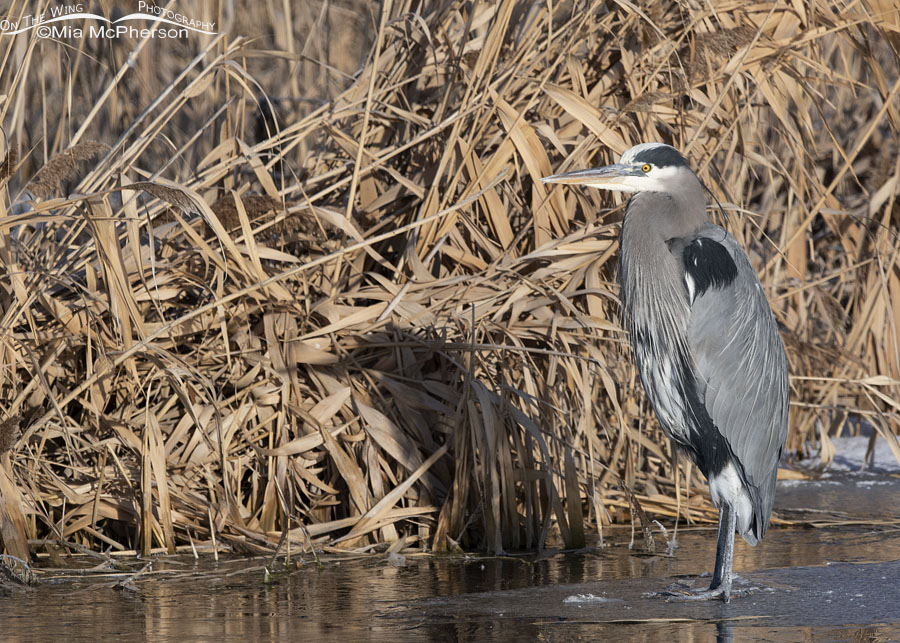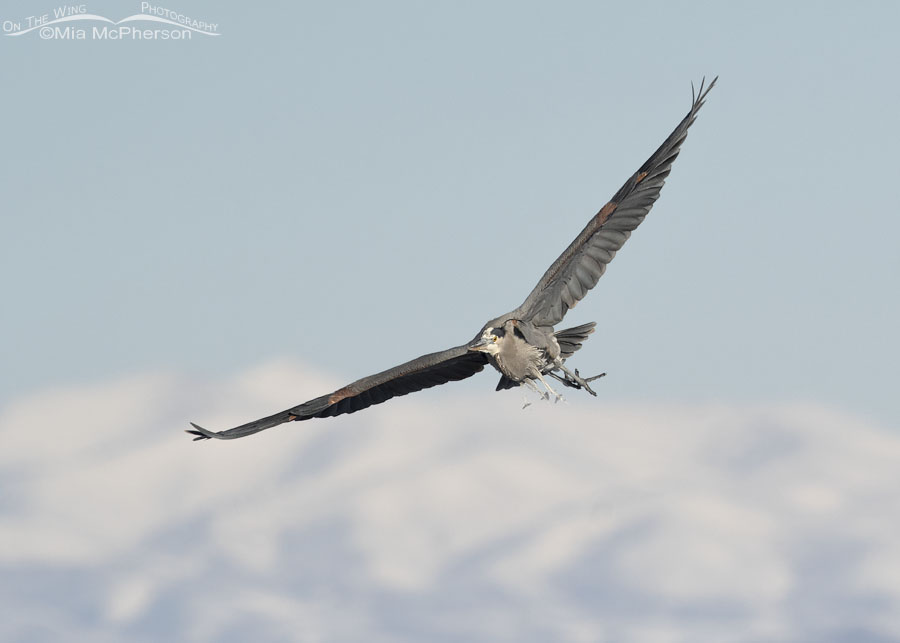The name “Great Blue Heron” has always seemed off to me because these large herons are much more gray than they are blue. As I scroll through my images of Great Blue Herons I find only a few photos where the slate-gray in their flight feathers would or could justify naming them “Great Blue Herons” and far more where their plumage is mostly gray or gray-brown.
 Great Blue Heron on a frigid morning in marsh habitat – Nikon D500, f7.1, 1/2000, ISO 250, Nikkor 500mm VR, natural light
Great Blue Heron on a frigid morning in marsh habitat – Nikon D500, f7.1, 1/2000, ISO 250, Nikkor 500mm VR, natural light
To be fair in some light the plumage of Great Blue Herons can appear to look bluer than it actually is. For instance, when they are in a shadow or low light their plumage can look a bit on the blue side. Or in a fog.
But if you search on line or scroll through images of this species on Facebook or other photos sharing sites where you can find images of Great Blue Herons with plumage in shades of deep royal blue, indigo blue, Mountain Bluebird blue or even purple-blue. I have seen photos on stock photos sites where the images of Great Blue Herons are such a vivid blue that I cringe because I know that isn’t their natural color but the person looking to license an image of a Great Blue Heron might not know their birds well enough to be aware that they don’t actually look like that in real life. Sometimes the colors in those images are a shocking misrepresentation of this species.
 Great Blue Heron flying over the frozen marsh at Bear River MBR – Nikon D500, f7.1, 1/3200, ISO 400, +0.7 EV, Nikkor 500mm VR, natural light
Great Blue Heron flying over the frozen marsh at Bear River MBR – Nikon D500, f7.1, 1/3200, ISO 400, +0.7 EV, Nikkor 500mm VR, natural light
A more suitable name might have been “Great Gray Heron” because they are more gray than blue and they are North America’s largest heron but there is a slight wrinkle with that name because there is a similar looking Grey (gray) Heron that can be found in Europe, Asia and parts of Africa and having two gray herons might be confusing. I’ve seen novice birders misidentify Great Blue Herons in the U.S. as Grey Herons many times because they aren’t aware of how rare a sighting of that species in North America would be. Wandering Grey Herons have made it to North America about a dozen times.
Perhaps the “Great Heron” would be a better name for these mostly gray, large herons. The name “Great Blue Heron” does make me wonder what’s up with their name.
Life is good.
Mia
Click here to see more of my Great Blue Heron photos plus facts and information about this species.


A rose by any other name is still…….
Whatever and whyever they’re called, the GBH is one of my very favorite birds! (There’s also a lot of “it’s grey, but we’ll call it blue” naming going on in other animal species, so I wonder if that played a role.)
(There’s also a lot of “it’s grey, but we’ll call it blue” naming going on in other animal species, so I wonder if that played a role.)
Bird naming has frequently struck me as silly. Inserting ‘common’ into any birds title for starters.
What ever the name these roses smell as sweet…
Ii think in certain light they do look to be a slate blue.
Who gets to decide these things anyway?
Interesting!
Common Names are tough to figure out why. When they were named and what was going on at that time might be the history behind why.
Mia, I came upon the carcass of a Great Blue Heron when I was a teenager. I collected as many of the feathers as I could for my Indian costume. They were definitely a soft blue-gray.
Good point, Mia, but then, Black-crowned Night Herons aren’t really black, right?
Mia, THey are called that so as not to cofuse with the “Gray Heron” found in Canada! At least they call them that .
I have often wondered about the name too, as well as cringing at the sight of stock photos that show a Great Blue Heron as vividly blue. They are so majestic.